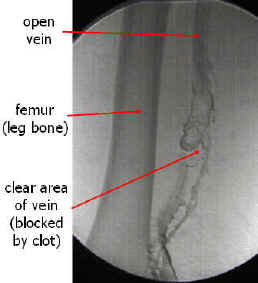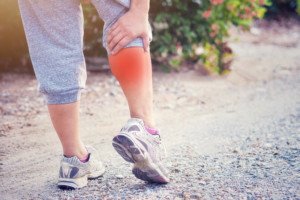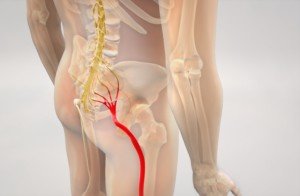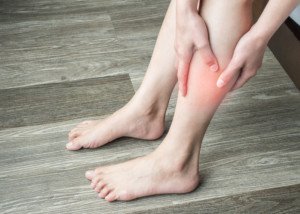
Can that pain in your calf that keeps coming and going, on and off, possibly be a DVT?
A deep vein thrombosis classically causes calf pain that’s hard to ignore.
“DVT refers to deep venous thrombosis, a blood clot forming usually in the lower legs, often resulting from prolonged slowing of blood flow after prolonged sitting or standing,” explains Morton Tavel, MD, Clinical Professor Emeritus of Medicine, Indiana University School of Medicine, and author of “Health Tips, Myths, and Tricks: A PHYSICIAN’S ADVICE.”
The prolonged sitting includes that which occurs on lengthy plane trips in which the flyer remains seated instead of periodically getting up and walking around to prevent blood pooling in their legs.
It also includes sitting for extended periods in a motor vehicle, legs cramped in a tight space – a situation ripe for DVT formation.
Other risk factors include obesity, a sedentary lifestyle, smoking, use of birth control pills, older age and recent joint replacement or abdominal surgery.
So when unexplained pain starts in a calf, those who are DVT-informed can’t help but wonder if the new pain, ache or soreness is coming from a blood clot.

More alarming is if the unexplained pain is constant, regardless of activity.
If the calf hurts even at rest, this brings on anxiety to anyone who knows about deep vein thrombosis.
But what if the calf pain comes and goes?
A blood clot itself, stuck in a vein, does not come and go. It’s either there or it’s not.
So it would seem that if it’s generating pain, cramps or a sore feeling, this sensation would be constant rather than randomly coming and going.
Dr. Tavel explains, “It is a painful condition, but is a single event that usually does not come and go.
“If one experiences calf pain that recurs, it is more likely some other condition for which one should seek further medical evaluation.”
Overworked or Tight Muscles
A common cause of a calf discomfort that’s not constant is a strained muscle.
At rest, all feels fine. But the moment one gets up and starts walking around, the soreness returns – particularly when going up a flight of stairs.
Once the person takes a seat or even stands still, the soreness subsides or completely disappears.
This strongly points to an overloaded or overstretched muscle rather than a DVT.

Shutterstock/TANAPAT LEK.JIW
If this describes your situation, ask yourself what you may have done in the past 24 hours that involved overworking the calf muscles.
• Did you walk faster than usual on the treadmill?
• Did you jog for the first time in a long time?
• Did the calf get overstretched in the middle of the night, cramping up like mad?
• How about a lot of stair climbing the prior day?
• Any new exercise moves? A hike? A long bike ride?
• Keep in mind that a harmless muscle strain in a limb often occurs on one side of the body. Don’t let the one-sided nature scare you.
This happens all the time (e.g., intense running causing pain in only one leg).
The common strained muscle will not cause redness, warmth or swelling to the affected area.
But a DVT sometimes will. If you have these additional symptoms, get to the emergency room for treatment ASAP.
A deep vein thrombosis can break off at any moment, travel to the lungs and cause life-threatening respiratory distress.
Constant calf pain isn’t always caused by a DVT.
The following conditions may cause lower leg discomfort (plus maybe tingling or numbness) on a constant basis, a come and go basis or triggered by activity or body position.
• Compartment syndrome. Excess blood or fluid wells up beneath tough tissues that don’t stretch well, putting pressure on nerves and blood vessels.
This can occur due to trauma or exercise. However, there may also be swelling, tingling and numbness.
• Sciatica. The sciatic nerve, which originates in the buttocks area and runs down the leg, could be irritated. Tingling is often present.

Shutterstock/Nathan Devery
• Achilles tendonitis. Tight calf muscles can put pressure on this large tendon, leading to pain.
• Arterial claudication. Think of this as “heart disease in the legs.” The arteries that supply the legs are narrowed or have blockages.
• Diabetic neuropathy. This nerve damage from diabetes can also cause tingling and numbness.
• Varicose veins. These enlarged veins often cause a crampy feeling in the lower leg.
If you have pain in only one calf that keeps coming and going, but no other symptoms, it’s probably just an over-stressed muscle.
If there’s swelling, warmth, redness or other discoloration, get medical attention ASAP – especially if you’ve recently endured a long airline flight or cramped quarters in a motor vehicle, or have any of the other risk factors for a DVT.

Dr. Tavel’s medical research includes over 125 publications, editorials and book reviews in peer-reviewed national medical journals. He was formerly director of the cardiac rehabilitation program at St. Vincent Hospital in Indiana. mortontavel.com
 Lorra Garrick has been covering medical, fitness and cybersecurity topics for many years, having written thousands of articles for print magazines and websites, including as a ghostwriter. She’s also a former ACE-certified personal trainer.
Lorra Garrick has been covering medical, fitness and cybersecurity topics for many years, having written thousands of articles for print magazines and websites, including as a ghostwriter. She’s also a former ACE-certified personal trainer.
.


























